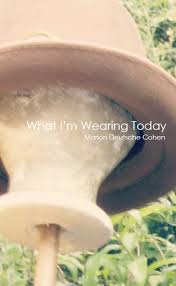
 .
.
.
Reviewed by Frank Wilson
.
The second of these volumes takes its title from a course Marion Deutsche Cohen developed and teaches at Arcadia University. The subtitle of that course is “Mathematics in Literature.”
Cohen’s day job is teaching math, and math figures a good deal in her poetry. Lest you think that might be off-putting, fear not. When it comes to math, I am without a trace of comprehension, and I had no problem at all with the references to sets, theorems, and the like. That’s because Cohen manages to communicate what it is like to have a passion for mathematics.
“Memoirs of a High-School Math-Brain,” from Closer to Dying, begins thus:
.
“The Parabola,” I announced.
“She would choose that one,” whispered three regular teenagers in the back row.
Yes, alas, I would.
.
The final stanza makes clear why:
Plenty of regular teenage girls got A’s in math.
But they didn’t prefer working on crossing polygons to going to a party.
And they didn’t write little squiggly geometry and algebra shapes in history class.
And they didn’t choose the parabola.
.
“Not as Much as Before,” one of the poems in Truth & Beauty is a response to students lamenting that they didn’t enjoy math in college as much as they had before college:
.
“… before college, I was like a kid in a candy store with math … The profundity of math could make me cry.
But in fact I didn’t really need the candy store … Candy was still candy even without the store and fifty years later I’m still a kid with candy. … Loving can come in spurts and it can come back ….
.
The poems in Truth & Beauty are based on homework questions and classroom conversations that students and their teacher have shared. They are prose poems. Now, the prose poem has not had much success in English. Cohen’s work precisely because she does not go out of her way to make them “poetic.” The “prosy” parts of “Not as Much as Before” provide just the right context for that “loving can come in spurts” phrase.
While the profundity of math may make people like Cohen cry, it is life that brings heartbreak, and math is no help for that, as “Proof Theory” makes plain:
.
Like when my third baby died, and the students all know about that, I tried to prove that she couldn’t possibly have died, I said things like “But I ate so healthily”, “I already had two successful pregnancies”. Prove it, God, how did you do it, how could it POSSIBLY have been done?”
.
Heartbreak itself, though, never dies:
.
A grave once opened for me.
It was so big, so wide, an entire small house.
And she whom they were lowering was twenty inches
six pounds, fourteen ounces, small enough
To have fit inside me.
.
The dispassionate precision of these lines only makes the grief more palpable. In “Dreams about One Way in Which Life Goes On,” we learn that the child’s name was Kerin: “I have another baby named Kerin and she also dies. / I say I lost two babies named Kerin … / Another night I lost yet another baby named Kerin. … How many nights can I keep this up?”
And then there is growing old, which means growing “closer to dying,” while visited by insomnia, insinuating dreams, together with pain and memory. Here is “One Brand of Insomnia”:
.
By day I play Mozart and Bach on the piano.
I play pretty well. I sort of conquer them.
But by night they’re back.
By night they’re conquering me.
.
This suggests, rather startlingly, that the two conquerings work in synergy. Something akin animates “50-Year High School Reunion”: “encountering my sixteen-year-old self. … I am hugging her, comforting her, advising her … Yes, I am advising her. And she is listening. She listened.”
Time to go shopping — or, more precisely, thrifting — and that is what Cohen does in a good many of the poems in What I’m Wearing Today. Math tags along, of course. In “Math in the Thrift Store,” an “ethnic hand-embroidered top” prompts interrogation:
.
What theorem are you? I ask it.
What is your proof?
What’s your Gödel number?
What’s your Gödel name?
.
But more than number resonates here. The speaker in “What I See in Thrift Stores” claims to seek space, time, “my past.” As in ”What I Wore in the 70s”:
.
I didn’t dress sexy.
I dressed arty.
I wasn’t a sex object.
I was an art object.
.
What it all adds up to is a fundamental mathematical truth: the terms on either side of an equal sign are just different ways of expressing the same thing. Cohen’s poems inevitably prove equal to their quotidian details. This is poetry not merely as a manner of speaking, but as an actual way of living.
.
Frank Wilson is a retired Inquirer book editor. Visit his blog Books, Inq. — The Epilogue. Email him at PresterFrank@gmail.com.